ThreadPoolExecutor简介
ThreadPoolExecutor是线程池类。对于线程池,可以通俗的将它理解为"存放一定数量线程的一个线程集合。
Executor框架最核心的类是ThreadPoolExecutor,它是线程池的实现类,主要由下列4个组件构成。
- ·corePoolSize:核心线程池的大小。
- ·maximumPool:最大线程池的大小。
- keepAliveTime: 当线程数量大于核心线程池大小的时候,线程(超出核心线程池大小的这部分)可以空闲的最长时间,超过这个时间线程将自动销毁。
- ·workQueue:用来暂时保存任务的工作队列。
- ·RejectedExecutionHandler:当ThreadPoolExecutor已经关闭或ThreadPoolExecutor已经饱和时(达到了最大线程池大小且工作队列已满),execute()方法将要调用的Handler。
ThreadPoolExecutor数据结构
ThreadPoolExecutor的数据结构如下图所示:
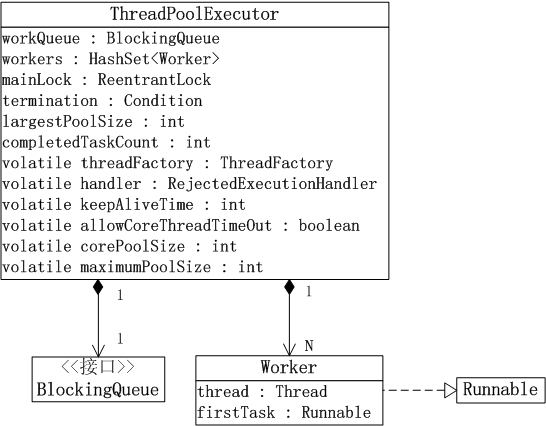
各个数据在ThreadPoolExecutor.java中的定义如下:
// 阻塞队列。 private final BlockingQueue<Runnable> workQueue; // 互斥锁 private final ReentrantLock mainLock = new ReentrantLock(); // 线程集合。一个Worker对应一个线程。 private final HashSet<Worker> workers = new HashSet<Worker>(); // “终止条件”,与“mainLock”绑定。 private final Condition termination = mainLock.newCondition(); // 线程池中线程数量曾经达到过的最大值。 private int largestPoolSize; // 已完成任务数量 private long completedTaskCount; // ThreadFactory对象,用于创建线程。 private volatile ThreadFactory threadFactory; // 拒绝策略的处理句柄。 private volatile RejectedExecutionHandler handler; // 保持线程存活时间。 private volatile long keepAliveTime; private volatile boolean allowCoreThreadTimeOut; // 核心池大小 private volatile int corePoolSize; // 最大池大小 private volatile int maximumPoolSize;
1. workers
workers是HashSet<Work>类型,即它是一个Worker集合。而一个Worker对应一个线程,也就是说线程池通过workers包含了"一个线程集合"。当Worker对应的线程池启动时,它会执行线程池中的任务;当执行完一个任务后,它会从线程池的阻塞队列中取出一个阻塞的任务来继续运行。
wokers的作用是,线程池通过它实现了"允许多个线程同时运行"。
2. workQueue
workQueue是BlockingQueue类型,即它是一个阻塞队列。当线程池中的线程数超过它的容量的时候,线程会进入阻塞队列进行阻塞等待。
通过workQueue,线程池实现了阻塞功能。
3. mainLock
mainLock是互斥锁,通过mainLock实现了对线程池的互斥访问。
4. corePoolSize和maximumPoolSize
corePoolSize是"核心池大小",maximumPoolSize是"最大池大小"。它们的作用是调整"线程池中实际运行的线程的数量"。
例如,当新任务提交给线程池时(通过execute方法)。
-- 如果此时,线程池中运行的线程数量< corePoolSize,则创建新线程来处理请求。
-- 如果此时,线程池中运行的线程数量> corePoolSize,但是却< maximumPoolSize;则仅当阻塞队列满时才创建新线程。
如果设置的 corePoolSize 和 maximumPoolSize 相同,则创建了固定大小的线程池。如果将 maximumPoolSize 设置为基本的无界值(如 Integer.MAX_VALUE),则允许池适应任意数量的并发任务。在大多数情况下,核心池大小和最大池大小的值是在创建线程池设置的;但是,也可以使用 setCorePoolSize(int) 和 setMaximumPoolSize(int) 进行动态更改。
5. poolSize
poolSize是当前线程池的实际大小,即线程池中任务的数量。
6. allowCoreThreadTimeOut和keepAliveTime
allowCoreThreadTimeOut表示是否允许"线程在空闲状态时,仍然能够存活";而keepAliveTime是当线程池处于空闲状态的时候,超过keepAliveTime时间之后,空闲的线程会被终止。
7. threadFactory
threadFactory是ThreadFactory对象。它是一个线程工厂类,"线程池通过ThreadFactory创建线程"。
8. handler
handler是RejectedExecutionHandler类型。它是"线程池拒绝策略"的句柄,也就是说"当某任务添加到线程池中,而线程池拒绝该任务时,线程池会通过handler进行相应的处理"。
newFixedThreadPool
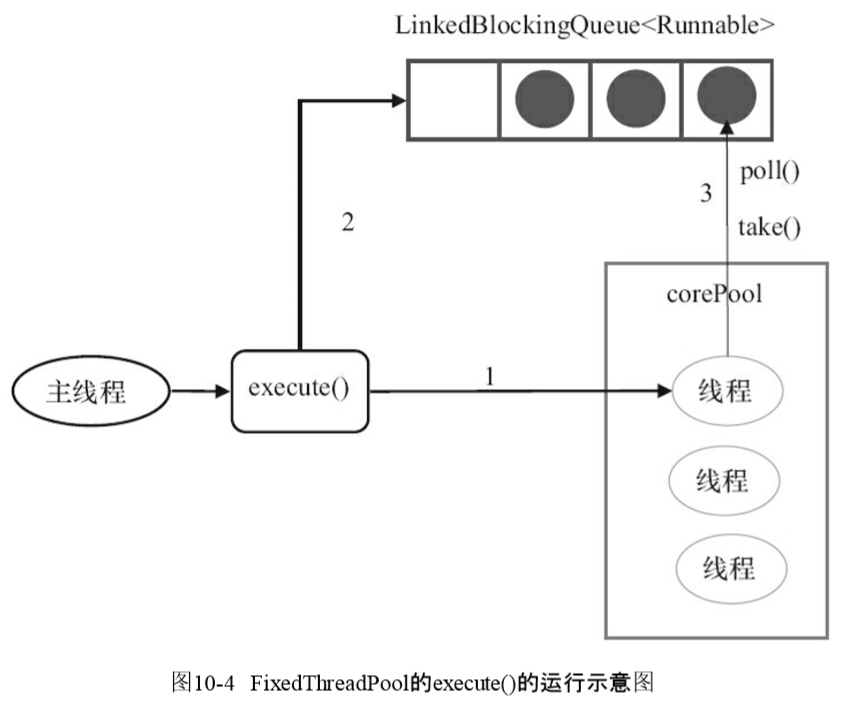
对图10-4的说明如下。
1,如果当前运行的线程数少于corePoolSize, 会立刻创建新线程执行任务。
2,当线程数到达corePoolSize后,将任务加入到LinkedBlockingQueue中。
3,当线程执行完任务后,会循环从LinkedBlockingQueue中获取任务来执行。
FixedThreadPool使用了LinkedBlockingQueue, 也就是无界队列(队列最大可容纳Integer.MAX_VALUE), 因此会造成以下影响:
a, 线程池线程数到达corePoolSize后,任务会被存放在LinkedBlockingQueue中
b, 因为无界队列,运行中(未调用shutdown()或者shutdownNow()方法)的不会拒绝任务(队列无界,可以放入"无限"任务)
使用举例:

1 public class FixedThreadPoolTest { 2 public static void main(String[] args) { 3 ExecutorService fixedThreadPool = Executors.newFixedThreadPool(4*20); 4 for (int i = 0; i < 10; i++) { 5 final int index = i; 6 fixedThreadPool.execute(new Runnable() { 7 public void run() { 8 try { 9 System.out.println(Thread.currentThread().getName()+">>"+index); 10 Thread.sleep(2000); 11 } catch (InterruptedException e) { 12 e.printStackTrace(); 13 } 14 } 15 }); 16 } 17 18 // // 此方法不阻塞, 调用后不再接收新的任务,所有线程池内任务执行完毕则关闭线程池 19 // fixedThreadPool.shutdown(); 20 // System.out.println("..........分割线............."); 21 // fixedThreadPool.execute(new Runnable() { 22 // @Override 23 // public void run() { 24 // System.out.println("run after shutdown......."); 25 // } 26 // }); 27 28 } 29 }
运行结果为:(会阻塞,因为线程池还没关闭)
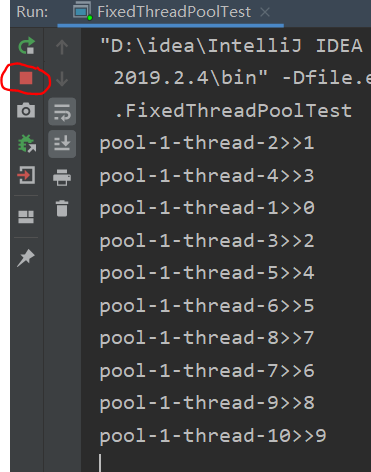
如果将上面的注释代码取消注释,运行结果为:

1 pool-1-thread-2>>1 2 pool-1-thread-5>>4 3 pool-1-thread-4>>3 4 pool-1-thread-1>>0 5 pool-1-thread-3>>2 6 pool-1-thread-6>>5 7 pool-1-thread-7>>6 8 pool-1-thread-8>>7 9 pool-1-thread-9>>8 10 pool-1-thread-10>>9 11 ..........分割线............. 12 Exception in thread "main" java.util.concurrent.RejectedExecutionException: Task com.test.lesson01.FixedThreadPoolTest$2@4b67cf4d rejected from java.util.concurrent.ThreadPoolExecutor@7ea987ac[Shutting down, pool size = 10, active threads = 10, queued tasks = 0, completed tasks = 0] 13 at java.util.concurrent.ThreadPoolExecutor$AbortPolicy.rejectedExecution(ThreadPoolExecutor.java:2063) 14 at java.util.concurrent.ThreadPoolExecutor.reject(ThreadPoolExecutor.java:830) 15 at java.util.concurrent.ThreadPoolExecutor.execute(ThreadPoolExecutor.java:1379) 16 at com.test.lesson01.FixedThreadPoolTest.main(FixedThreadPoolTest.java:26) 17 18 Process finished with exit code 1
不会阻塞
newSingleThreadExecutor
SingleThreadExecutor是使用单个worker线程的Executor
SingleThreadExecutor的corePoolSize和maximumPoolSize被设置为1。其他参数与 FixedThreadPool相同。SingleThreadExecutor使用无界队列LinkedBlockingQueue作为线程池的工 作队列(队列的容量为Integer.MAX_VALUE)。SingleThreadExecutor使用无界队列作为工作队列 对线程池带来的影响与FixedThreadPool相同,这里就不赘述了。
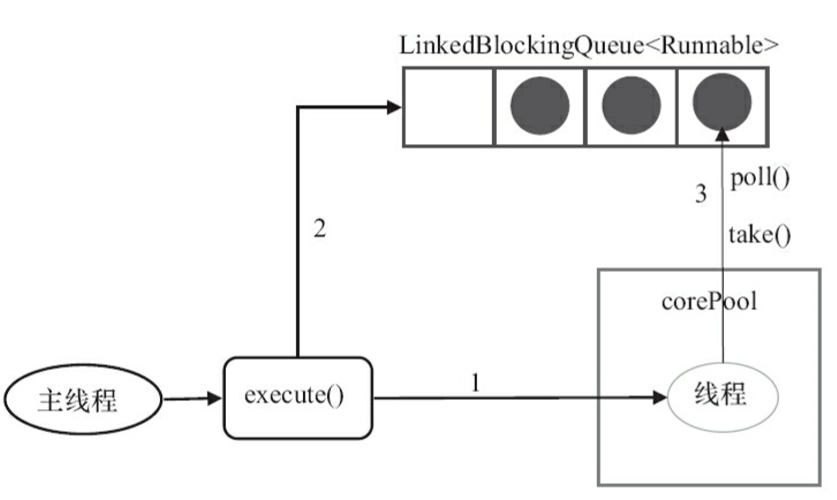
对图10-5的说明如下。
1)如果当前运行的线程数少于corePoolSize(即线程池中无运行的线程),则创建一个新线
程来执行任务。
2)在线程池完成预热之后(当前线程池中有一个运行的线程),将任务加入LinkedBlockingQueue。
3)线程执行完1中的任务后,会在一个无限循环中反复从LinkedBlockingQueue获取任务来
执行。
举例:

1 public class SingleThreadExecutorTest { 2 3 public static void main(String[] args) { 4 ExecutorService singleThreadExecutor = Executors.newSingleThreadExecutor(); 5 for (int i = 0; i < 10; i++) { 6 final int index = i; 7 Runnable task = new Runnable() { 8 public void run() { 9 try { 10 System.out.println(Thread.currentThread().getName()+">>"+index); 11 Thread.sleep(1000); 12 } catch (InterruptedException e) { 13 e.printStackTrace(); 14 } 15 } 16 }; 17 singleThreadExecutor.execute(task); 18 } 19 20 singleThreadExecutor.shutdown(); 21 } 22 23 }
结果为:(每隔1秒就会打印一个输出)

newCachedThreadPool
CachedThreadPool是一个会根据需要创建新线程的线程池。CachedThreadPool的corePoolSize被设置为0,即corePool为空;maximumPoolSize被设置为 Integer.MAX_VALUE,即maximumPool是无界的。这里把keepAliveTime设置为60L,意味着 CachedThreadPool中的空闲线程等待新任务的最长时间为60秒,空闲线程超过60秒后将会被终止。
FixedThreadPool和SingleThreadExecutor使用无界队列LinkedBlockingQueue作为线程池的 工作队列。CachedThreadPool使用没有容量的SynchronousQueue作为线程池的工作队列,但 CachedThreadPool的maximumPool是无界的。这意味着,如果主线程提交任务的速度高于 maximumPool中线程处理任务的速度时,CachedThreadPool会不断创建新线程。极端情况下, CachedThreadPool会因为创建过多线程而耗尽CPU和内存资源。
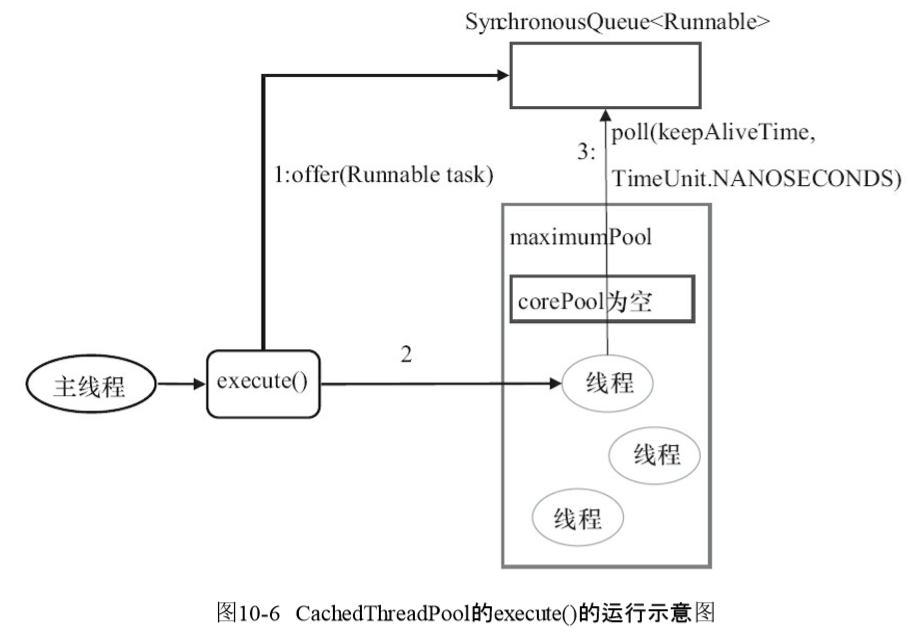
对图10-6的说明如下。
1)首先执行SynchronousQueue.offer(Runnable task)。如果当前maximumPool中有空闲线程 正在执行SynchronousQueue.poll(keepAliveTime,TimeUnit.NANOSECONDS),那么主线程执行 offer操作与空闲线程执行的poll操作配对成功,主线程把任务交给空闲线程执行,execute()方 法执行完成;否则执行下面的步骤2)。
2)当初始maximumPool为空,或者maximumPool中当前没有空闲线程时,将没有线程执行 SynchronousQueue.poll(keepAliveTime,TimeUnit.NANOSECONDS)。这种情况下,步骤1)将失 败。此时CachedThreadPool会创建一个新线程执行任务,execute()方法执行完成。
3)在步骤2)中新创建的线程将任务执行完后,会执行 SynchronousQueue.poll(keepAliveTime,TimeUnit.NANOSECONDS)。这个poll操作会让空闲线
程最多在SynchronousQueue中等待60秒钟。如果60秒钟内主线程提交了一个新任务(主线程执 行步骤1)),那么这个空闲线程将执行主线程提交的新任务;否则,这个空闲线程将终止。由于 空闲60秒的空闲线程会被终止,因此长时间保持空闲的CachedThreadPool不会使用任何资源。
前面提到过,SynchronousQueue是一个没有容量的阻塞队列。每个插入操作必须等待另一 个线程的对应移除操作,反之亦然。CachedThreadPool使用SynchronousQueue,把主线程提交的 任务传递给空闲线程执行。CachedThreadPool中任务传递的示意图如图10-7所示。
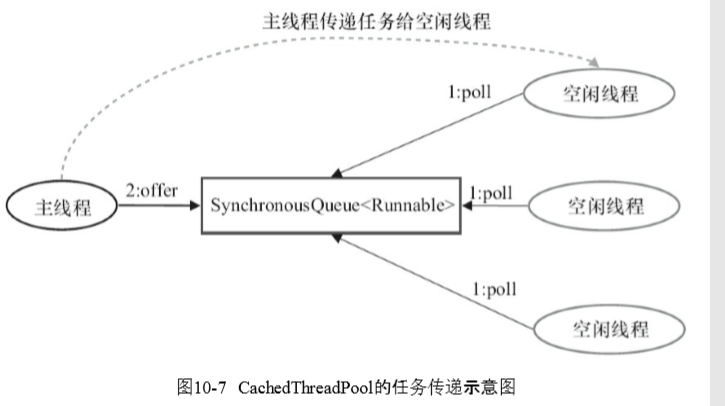
使用举例:

1 package com.test.lesson01; 2 3 import java.util.concurrent.ExecutorService; 4 import java.util.concurrent.Executors; 5 6 public class CachedThreadPoolTest { 7 8 public static void main(String[] args) { 9 ExecutorService cachedThreadPool = Executors.newCachedThreadPool(); 10 for (int i = 0; i < 10; i++) { 11 final int index = i; 12 /*try { 13 Thread.sleep(1000); 14 } catch (InterruptedException e) { 15 e.printStackTrace(); 16 }*/ 17 Runnable task = new Runnable() { 18 public void run() { 19 try { 20 Thread.sleep(1000); 21 } catch (InterruptedException e) { 22 e.printStackTrace(); 23 } 24 System.out.println(Thread.currentThread().getName()+">>"+index+","+Thread.currentThread().hashCode()); 25 } 26 }; 27 cachedThreadPool.execute(task); 28 } 29 } 30 31 }
结果为:

1 pool-1-thread-9>>8,1119372326 2 pool-1-thread-5>>4,2118164867 3 pool-1-thread-8>>7,1955604205 4 pool-1-thread-6>>5,1242746377 5 pool-1-thread-1>>0,1296698618 6 pool-1-thread-4>>3,188351009 7 pool-1-thread-10>>9,1881928750 8 pool-1-thread-7>>6,282966402 9 pool-1-thread-3>>2,1447026184 10 pool-1-thread-2>>1,278180759
并且,上述运行在1分钟后就会终止,因为CachedThreadPool在没有任务继续提交的时候就会关闭线程池。上面的线程的名字都是一样的,是因为任务执行时间很短,任务已经执行完了,线程池都还没有关闭,下一个任务来了直接可以采用刚刚的缓存的线程来执行任务。
如果将上面的休眠时间取消注释,将会出现如下结果:

1 pool-1-thread-1>>0,1986922183 2 pool-1-thread-2>>1,903833002 3 pool-1-thread-1>>2,1986922183 4 pool-1-thread-2>>3,903833002 5 pool-1-thread-1>>4,1986922183 6 pool-1-thread-2>>5,903833002 7 pool-1-thread-1>>6,1986922183 8 pool-1-thread-2>>7,903833002 9 pool-1-thread-1>>8,1986922183 10 pool-1-thread-2>>9,903833002
出现这种情况是因为当下次任务来的时候,上次的任务还没执行结束,线程池中只好再新建立一个线程来执行这个新到的任务。当没有任务需要执行的时候,程序运行将在1分钟后自动结束。
参考文献:
《Java并发编程艺术》
https://www.cnblogs.com/skywang12345/p/3509941.html

